
- Getting Started
- Quick Start
- Why BrowserUp?
- Coding your Load Test
- Proxy Config
- Load Test Config
- BrowserUp API
- Load Test
- Playwright Load Test
- Postman Load Test
- Ruby Load Test
- Java Load Test
- Python Load Test
- Internet Of Things
- Browser Core Web Vitals
- Load Test with C# (DotNet)
- Load Test with Selenium
- Load Testing Websockets
- Load Testing Containers
- Reporting
- Reports
- Studio
- Command Line Util
- load start
- load stop
- load verify
- load init
- cluster install
- cluster deploy
- cluster destroy
- cluster upload-license
- Admin
- Audit Logs
- User Access
- Workspaces
- Licensing
- Health check

